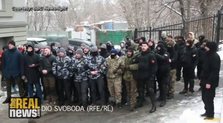22 aug 2018
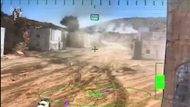
The new and improved version of the Merkava IV, which will make its debut on the battlefield in 3 years, will be kitted with advanced systems offering extra crew protection, increased strike efficiency.
The Merkava Mark IV tank, currently used by the IDF's Armored Corps, is undergoing a series of improvements that will be seen on the battlefield in three years in the form of its successor tank—the Merkava Mark IV Barak.
The new tank will include advanced technology systems that are expected to make it more lethal, faster and more secure than the current Merkava Mark-4.
It will also be kitted with an artificial intelligence system that includes a smart task computer to integrate the various tasks being carried out by the tank’s systems.
The mission computer will be responsible for receiving all data from the operational network and tank systems, analyzing the information, and bringing it to the attention of the commander in accordance with the urgency and relevance of the information.
"In this way, the computer will reduce the burden on the crew members, improve the reliability of the system, pinpoint targets and improve the chances of hitting them," the IDF explained. “The Barak tank will also come with an improved cannon and commander’s gun sight."
The new tank will also be equipped with a series of sensors and new gear, such as the Iron Vision helmet, which will enable the fighters to maneuver in dense urban areas without removing their heads from the tank and exposing themselves to enemy fire, while enjoying a 360 degree view of their surroundings.
The internal operational qualities of the tank will also undergo an unprecedented technological facelift. With modern touch screens replacing the chunky switch pads, the work environment inside the tank will be more convenient and simple to operate for a generation unfamiliar with outdated buttons.
With advanced defense capabilities (an improved anti-missile Trophy system) and process automation, the tank will ease the burden on the crew by directing them according to mission urgency.
In addition to the new tank, the tradtional composition of an armored company will soon be changed with the addage of a tenth tank and an additional commanding officer to each company. Most of the tanks in the corps will be commanded by a commissioned officer.
The IDF noted that "this change allows for a greater impact on the battlefield as well as flexibility in broad operations. This change comes from the understanding that the future battlefield will require having more people with decision making abilities and a broad understanding of the operational environment."
Meanwhile, senior officers in the Armored Corps said that after last year’s ‘crisis of motivation’ to join the Armored Corps ranks, there has been an improvement among recent recruits who want to serve in tank brigades, owing to public relations efforts.
According to army figures, for every available spot in the Armored Corps, there is slightly more than one recruit competing for it. In the March 2018 draft, 83% of new recruits indicated that they wanted to serve in the Armored Corps, while in November 2016 the number was only 54%.
As part of the efforts to increase motivation, potential recruits were told about the many operational activities carried out by the tank units—even during relatively peaceful periods.
Since the beginning of the year, the Armored Corps has hit more than 20 terrorists in the Gaza Strip and destroyed about 30 terrorist infrastructure targets. These actions included the firing of 81 shells, the killing of 12 terrorists and the wounding of ten.
The Merkava Mark IV tank, currently used by the IDF's Armored Corps, is undergoing a series of improvements that will be seen on the battlefield in three years in the form of its successor tank—the Merkava Mark IV Barak.
The new tank will include advanced technology systems that are expected to make it more lethal, faster and more secure than the current Merkava Mark-4.
It will also be kitted with an artificial intelligence system that includes a smart task computer to integrate the various tasks being carried out by the tank’s systems.
The mission computer will be responsible for receiving all data from the operational network and tank systems, analyzing the information, and bringing it to the attention of the commander in accordance with the urgency and relevance of the information.
"In this way, the computer will reduce the burden on the crew members, improve the reliability of the system, pinpoint targets and improve the chances of hitting them," the IDF explained. “The Barak tank will also come with an improved cannon and commander’s gun sight."
The new tank will also be equipped with a series of sensors and new gear, such as the Iron Vision helmet, which will enable the fighters to maneuver in dense urban areas without removing their heads from the tank and exposing themselves to enemy fire, while enjoying a 360 degree view of their surroundings.
The internal operational qualities of the tank will also undergo an unprecedented technological facelift. With modern touch screens replacing the chunky switch pads, the work environment inside the tank will be more convenient and simple to operate for a generation unfamiliar with outdated buttons.
With advanced defense capabilities (an improved anti-missile Trophy system) and process automation, the tank will ease the burden on the crew by directing them according to mission urgency.
In addition to the new tank, the tradtional composition of an armored company will soon be changed with the addage of a tenth tank and an additional commanding officer to each company. Most of the tanks in the corps will be commanded by a commissioned officer.
The IDF noted that "this change allows for a greater impact on the battlefield as well as flexibility in broad operations. This change comes from the understanding that the future battlefield will require having more people with decision making abilities and a broad understanding of the operational environment."
Meanwhile, senior officers in the Armored Corps said that after last year’s ‘crisis of motivation’ to join the Armored Corps ranks, there has been an improvement among recent recruits who want to serve in tank brigades, owing to public relations efforts.
According to army figures, for every available spot in the Armored Corps, there is slightly more than one recruit competing for it. In the March 2018 draft, 83% of new recruits indicated that they wanted to serve in the Armored Corps, while in November 2016 the number was only 54%.
As part of the efforts to increase motivation, potential recruits were told about the many operational activities carried out by the tank units—even during relatively peaceful periods.
Since the beginning of the year, the Armored Corps has hit more than 20 terrorists in the Gaza Strip and destroyed about 30 terrorist infrastructure targets. These actions included the firing of 81 shells, the killing of 12 terrorists and the wounding of ten.
5 aug 2018

US senators are quietly paving the way for a military aid to Israel that exceeds $3.8 billion.
The number would amount to $23,000 per year for every family in Israel, according to a Friday report by Minnesota-based news website MintPress News, released amid a media blackout.
American senators passed a bill titled the “United States-Israel Security Assistance Authorization Act of 2018,” on Wednesday, paving the way for its likely approval by the US House of Representatives within the week.
The amount is a result of a memorandum of understanding on security assistance between Washington and Tel Aviv.
The funding involves an additional $550 million aid for Israeli missile systems and $1 billion for US weapons stockpiles in Israel.
US military aid to Israel has skyrocketed over the past several years while the regime’s forces are engaged in blatant human rights violations against Palestinians in Gaza and elsewhere.
Hailed as a “great friend to the Jewish people” by Israeli Prime Minister Benjamin Netanyahu, US President Donald Trump has boosted ties with Israel.
The US president finally broke with decades of US policy by announcing that the embassy in Israel would be relocated from Tel Aviv to the holy city of Jerusalem al-Quds.
Trump made the move despite foreign leaders’ warnings that it could stoke further tensions in the region.
The Israeli regime, meanwhile, continues its atrocities and expansionist policies in the region.
The number would amount to $23,000 per year for every family in Israel, according to a Friday report by Minnesota-based news website MintPress News, released amid a media blackout.
American senators passed a bill titled the “United States-Israel Security Assistance Authorization Act of 2018,” on Wednesday, paving the way for its likely approval by the US House of Representatives within the week.
The amount is a result of a memorandum of understanding on security assistance between Washington and Tel Aviv.
The funding involves an additional $550 million aid for Israeli missile systems and $1 billion for US weapons stockpiles in Israel.
US military aid to Israel has skyrocketed over the past several years while the regime’s forces are engaged in blatant human rights violations against Palestinians in Gaza and elsewhere.
Hailed as a “great friend to the Jewish people” by Israeli Prime Minister Benjamin Netanyahu, US President Donald Trump has boosted ties with Israel.
The US president finally broke with decades of US policy by announcing that the embassy in Israel would be relocated from Tel Aviv to the holy city of Jerusalem al-Quds.
Trump made the move despite foreign leaders’ warnings that it could stoke further tensions in the region.
The Israeli regime, meanwhile, continues its atrocities and expansionist policies in the region.
29 july 2018

The City Councils of Naples, Turin, Bologna, Florence and Pisa have all demanded their respective state governments and the international community to impose military embargo against Israel and to hold it accountable for its repeated crimes against Palestinians.
The cities called for this action in compliance with the European Union Code of Conduct on arms exports as Italy is considered one of the main arms exporters to Israel.
The BDS group in Italy urged all Italian City Councils to join the military embargo campaign and to the take real actions to guarantee respect for Italian as well as international humanitarian laws.
For its part, the BDS National Committee in Gaza hailed the Italian cities for their decisions to military boycott Israel, which is one of the most important forms of solidarity with the Palestinian people and of supporting popular peaceful resistance against the Israeli occupation.
The cities called for this action in compliance with the European Union Code of Conduct on arms exports as Italy is considered one of the main arms exporters to Israel.
The BDS group in Italy urged all Italian City Councils to join the military embargo campaign and to the take real actions to guarantee respect for Italian as well as international humanitarian laws.
For its part, the BDS National Committee in Gaza hailed the Italian cities for their decisions to military boycott Israel, which is one of the most important forms of solidarity with the Palestinian people and of supporting popular peaceful resistance against the Israeli occupation.
9 july 2018
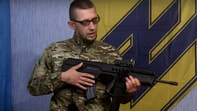
An Azov militiaman with a Tavor rifle
Human rights activists petition the court to cease Israeli arms exports to Ukraine since some of these weapons reach neo-Nazi elements in Ukraine’s security forces.
A group of more than 40 human rights activists have filed a petition with the High Court of Justice, demanding the cessation of Israeli arms exports to Ukraine.
They argue that these weapons serve forces that openly espouse a neo-Nazi ideology and cite evidence that the right-wing Azov militia, whose members are part of Ukraine’s armed forces, and are supported by the country’s ministry of internal affairs, is using these weapons.
An earlier appeal to the Defense Ministry was met with no response.
The ministry’s considerations in granting export licenses for armaments are not disclosed to the public, but it appears that the appearance of Israeli weapons in the hands of avowed neo-Nazis should be a consideration used in opposing the granting of such a license.
Nevertheless, this is not the first time in which the defense establishment is arming forces that embrace a national socialist ideology.
In the past, Israel has armed anti-Semitic regimes, such as the generals’ regime in Argentina, which murdered thousands of Jews in camps while its soldiers stood in watchtowers guarding the abducted prisoners with their Uzi submachine guns.
According to a freedom of information petition to Israel's defense ministry from last January (Hebrew: read in full here PDF), Israel also armed Bolivia's military regimes, knowing that Nazi war criminal Klaus Barbie was part of the regime. Legal documents used to convict the head of the junta also showed that Barbie's death squads used Israeli Uzis.
In the case of Ukraine forces using Israeli weapons are openly stating their support for racist and anti-Semitic ideas, in various publications.
The Azov militia was established in Ukraine following the Russian invasion of the Crimean peninsula in 2014. The militia’s emblems are well-known national socialist ones. Its members use the Nazi salute and carry swastikas and SS insignias.
Moreover, some of them openly admit they have neo-Nazi sentiments and that they are Holocaust deniers. One militia member said in an interview that he was fighting Russia since Putin was a Jew. An Azov sergeant said that he was a national socialist, although he was not in favor of genocide, and as long as minorities in Ukraine did not demand special rights he would have no problem with them.
The militia’s founder, Andriy Biletsky, who is now a member of Ukraine’s parliament, formerly headed a neo-Nazi group called Patriot of Ukraine, now defunct. Its members comprise the founding core of Azov.
“Our nation’s historic mission at this critical juncture is to lead the final march of the white race towards its survival” Biletsky has said. “This is a march against sub-humans who are led by the Semite race.” According to reports by human rights groups militia members are suspected of war crimes, torture and sexual violence.
In tandem with the rising power of Azov, which has more than 3,000 members, there is a rise in anti-Semitic incidents and attacks against Ukraine’s minorities. Neo-Nazi groups have attacked Jews and Jewish memorial sites across Ukraine, as well as journalists, Roma and members of the LGBT community.
One member of parliament declared, in response to a question about the country’s “Jewish problem”, that “in the government there is non-Ukrainian bloodthis must be addressed.” Last May right-wing groups marched through Odessa, their leaders claiming that the city belongs to Ukrainians, not Jews, and that they would get rid of the latter.
All this is happening as the Ukrainian administration is trying to deny the country’s role in the Holocaust, just as is happening in Poland (now with the support of the Netanyahu government).
These attempts include rewriting the history of World War II and the glorification of Ukraine’s soldiers, using legislation and various publications, as well as concocting stories about Jews who were allies of national Ukrainian forces during the war, whereas in fact Jews had to hide their identity.
In 2015, the Holocaust Museum in Washington denounced Ukrainian legislation which was intended to prevent criticism of collaboration with the Nazis.
The Simon Wiesenthal Center and the World Jewish Congress condemned the decision to name central boulevards in Kiev after Nazi collaborators. If that weren’t enough, last April there was a march honoring Ukrainian Waffen SS units which massacred thousands of Jews during World War II. In June, Ukraine’s chief military prosecutor Anatoli Matios said in an interview that Jews want “to drown Slavs in blood.”
Since the spring of 2015 members of the Azov militia have been part of the regular security forces in Ukraine, a part of the National Guard which is under the country’s ministry of internal affairs. The militia encourages members and supporters to enlist in the army. However, the militia maintains itself as a separate organization.
In December of 2016 Ukraine’s internal affairs minister Arsen Avakov, considered Azov’s patron and a candidate for prime minister, met a Knesset delegation headed by MK David Amsalem, on an official visit to Ukraine.
Avakov has also met Arye Dery, the minister of interior. Avakov appointed Vadym Troyan, a senior Azov commander, as the head of Kiev’s police force. Another militia founder was given a different senior police post. These ties were formed when Avakov was a regional governor, cooperating with the neo-Nazi forces of the Patriot of Ukraine, the forerunner of Azov.
Last January the U.S. Congress prohibited any support for the Ukrainian militia. Since Israel’s defense ministry does not divulge any information on arms exports, particularly not to Ukraine, for fear of Russian wrath, it’s difficult to assess the extent of the ties with Kiev, but these are certainly in place.
The petition, submitted by attorney Itay Mack, contains abundant evidence showing the arming of the Ukrainian regime and its Azov forces.
Thus, for example, Ukrainian soldiers have been seen carrying Israeli-made Tavor rifles in military parades in Kiev. In February 2016 it was revealed that Elbit Systems will be part of a group investing in Ukraine’s defense establishment.
In April 2016 the chief of Ukraine’s air force met a representative of an Israeli defense company to discuss the upgrading of communications systems in that country’s warplanes and helicopters. The Ukrainian company “Fort” got Israel’s approval for making Tavor, Negev and Galil rifles.
In the city of Dnepropetrovsk in eastern Ukraine there is a military training school. Its website indicates that training there is provided former IDF officers and that its instructors were trained by Israelis.
The website has a photo of shooting practice with a Tavor rifle. It notes that the school trains units of the National Guard, whose members include Azov militiamen.
In May 2017 Ukraine’s Prime Minister Volodymyr Groysman visited Israel and met with Defense Minister Avigdor Lieberman to discuss the arming of Ukraine’s military forces.
In December of that year a man claiming to be a former IDF officer was interviewed by Ukrainian media, saying that he had taken part in battles in eastern Ukraine, where he was instructing soldiers. The Azov website also shows militia members using Tavor rifles.
All of this is unambiguous proof that Israel is exporting weapons to Ukraine, knowing that they reach right-wing militias, some members of which are avowed neo-Nazis who enjoy the support of the authorities.
The ministry of defense, as is its wont, refuses to address this issue, responding only in generalities without detailing the considerations underlying its decisions approving arms exports. It seems that in this case the public deserves a more detailed response, as do Ukrainian Jews the Israeli government supposedly claims to protect.
Even if these weapons are currently directed at Russians, one should take into account the reasonable possibility that in the future they will be used to achieve other goals, perhaps aimed at minority groups in the country. It will then be too late to halt the collaboration of the Israeli establishment with the murder of Jews and others. This will be one more chapter in the dismal history of using Israeli firearms in acts such as these.
Human rights activists petition the court to cease Israeli arms exports to Ukraine since some of these weapons reach neo-Nazi elements in Ukraine’s security forces.
A group of more than 40 human rights activists have filed a petition with the High Court of Justice, demanding the cessation of Israeli arms exports to Ukraine.
They argue that these weapons serve forces that openly espouse a neo-Nazi ideology and cite evidence that the right-wing Azov militia, whose members are part of Ukraine’s armed forces, and are supported by the country’s ministry of internal affairs, is using these weapons.
An earlier appeal to the Defense Ministry was met with no response.
The ministry’s considerations in granting export licenses for armaments are not disclosed to the public, but it appears that the appearance of Israeli weapons in the hands of avowed neo-Nazis should be a consideration used in opposing the granting of such a license.
Nevertheless, this is not the first time in which the defense establishment is arming forces that embrace a national socialist ideology.
In the past, Israel has armed anti-Semitic regimes, such as the generals’ regime in Argentina, which murdered thousands of Jews in camps while its soldiers stood in watchtowers guarding the abducted prisoners with their Uzi submachine guns.
According to a freedom of information petition to Israel's defense ministry from last January (Hebrew: read in full here PDF), Israel also armed Bolivia's military regimes, knowing that Nazi war criminal Klaus Barbie was part of the regime. Legal documents used to convict the head of the junta also showed that Barbie's death squads used Israeli Uzis.
In the case of Ukraine forces using Israeli weapons are openly stating their support for racist and anti-Semitic ideas, in various publications.
The Azov militia was established in Ukraine following the Russian invasion of the Crimean peninsula in 2014. The militia’s emblems are well-known national socialist ones. Its members use the Nazi salute and carry swastikas and SS insignias.
Moreover, some of them openly admit they have neo-Nazi sentiments and that they are Holocaust deniers. One militia member said in an interview that he was fighting Russia since Putin was a Jew. An Azov sergeant said that he was a national socialist, although he was not in favor of genocide, and as long as minorities in Ukraine did not demand special rights he would have no problem with them.
The militia’s founder, Andriy Biletsky, who is now a member of Ukraine’s parliament, formerly headed a neo-Nazi group called Patriot of Ukraine, now defunct. Its members comprise the founding core of Azov.
“Our nation’s historic mission at this critical juncture is to lead the final march of the white race towards its survival” Biletsky has said. “This is a march against sub-humans who are led by the Semite race.” According to reports by human rights groups militia members are suspected of war crimes, torture and sexual violence.
In tandem with the rising power of Azov, which has more than 3,000 members, there is a rise in anti-Semitic incidents and attacks against Ukraine’s minorities. Neo-Nazi groups have attacked Jews and Jewish memorial sites across Ukraine, as well as journalists, Roma and members of the LGBT community.
One member of parliament declared, in response to a question about the country’s “Jewish problem”, that “in the government there is non-Ukrainian bloodthis must be addressed.” Last May right-wing groups marched through Odessa, their leaders claiming that the city belongs to Ukrainians, not Jews, and that they would get rid of the latter.
All this is happening as the Ukrainian administration is trying to deny the country’s role in the Holocaust, just as is happening in Poland (now with the support of the Netanyahu government).
These attempts include rewriting the history of World War II and the glorification of Ukraine’s soldiers, using legislation and various publications, as well as concocting stories about Jews who were allies of national Ukrainian forces during the war, whereas in fact Jews had to hide their identity.
In 2015, the Holocaust Museum in Washington denounced Ukrainian legislation which was intended to prevent criticism of collaboration with the Nazis.
The Simon Wiesenthal Center and the World Jewish Congress condemned the decision to name central boulevards in Kiev after Nazi collaborators. If that weren’t enough, last April there was a march honoring Ukrainian Waffen SS units which massacred thousands of Jews during World War II. In June, Ukraine’s chief military prosecutor Anatoli Matios said in an interview that Jews want “to drown Slavs in blood.”
Since the spring of 2015 members of the Azov militia have been part of the regular security forces in Ukraine, a part of the National Guard which is under the country’s ministry of internal affairs. The militia encourages members and supporters to enlist in the army. However, the militia maintains itself as a separate organization.
In December of 2016 Ukraine’s internal affairs minister Arsen Avakov, considered Azov’s patron and a candidate for prime minister, met a Knesset delegation headed by MK David Amsalem, on an official visit to Ukraine.
Avakov has also met Arye Dery, the minister of interior. Avakov appointed Vadym Troyan, a senior Azov commander, as the head of Kiev’s police force. Another militia founder was given a different senior police post. These ties were formed when Avakov was a regional governor, cooperating with the neo-Nazi forces of the Patriot of Ukraine, the forerunner of Azov.
Last January the U.S. Congress prohibited any support for the Ukrainian militia. Since Israel’s defense ministry does not divulge any information on arms exports, particularly not to Ukraine, for fear of Russian wrath, it’s difficult to assess the extent of the ties with Kiev, but these are certainly in place.
The petition, submitted by attorney Itay Mack, contains abundant evidence showing the arming of the Ukrainian regime and its Azov forces.
Thus, for example, Ukrainian soldiers have been seen carrying Israeli-made Tavor rifles in military parades in Kiev. In February 2016 it was revealed that Elbit Systems will be part of a group investing in Ukraine’s defense establishment.
In April 2016 the chief of Ukraine’s air force met a representative of an Israeli defense company to discuss the upgrading of communications systems in that country’s warplanes and helicopters. The Ukrainian company “Fort” got Israel’s approval for making Tavor, Negev and Galil rifles.
In the city of Dnepropetrovsk in eastern Ukraine there is a military training school. Its website indicates that training there is provided former IDF officers and that its instructors were trained by Israelis.
The website has a photo of shooting practice with a Tavor rifle. It notes that the school trains units of the National Guard, whose members include Azov militiamen.
In May 2017 Ukraine’s Prime Minister Volodymyr Groysman visited Israel and met with Defense Minister Avigdor Lieberman to discuss the arming of Ukraine’s military forces.
In December of that year a man claiming to be a former IDF officer was interviewed by Ukrainian media, saying that he had taken part in battles in eastern Ukraine, where he was instructing soldiers. The Azov website also shows militia members using Tavor rifles.
All of this is unambiguous proof that Israel is exporting weapons to Ukraine, knowing that they reach right-wing militias, some members of which are avowed neo-Nazis who enjoy the support of the authorities.
The ministry of defense, as is its wont, refuses to address this issue, responding only in generalities without detailing the considerations underlying its decisions approving arms exports. It seems that in this case the public deserves a more detailed response, as do Ukrainian Jews the Israeli government supposedly claims to protect.
Even if these weapons are currently directed at Russians, one should take into account the reasonable possibility that in the future they will be used to achieve other goals, perhaps aimed at minority groups in the country. It will then be too late to halt the collaboration of the Israeli establishment with the murder of Jews and others. This will be one more chapter in the dismal history of using Israeli firearms in acts such as these.
6 july 2018

July 5, 2018 / Palestinian Boycott, Divestment and Sanctions National Committee (BNC)
The Council of the Socialist International (SI) has called for Boycott, Divestment and Sanctions (BDS) for Palestinian rights at their meeting in the United Nations in Geneva on June 26-27. SI also called for a “total embargo on all forms of military trade and cooperation with Israel.”
Socialist International brings together 140 global political parties, including 35 parties in government in South Africa, Argentina, Spain, Colombia, Portugal, Tanzania, Luxemburg, Romania, Iraq and elsewhere.
The SI has reaffirmed the Palestinian people’s right to self-determination and called on governments and civil organizations to “activate Boycott, divestment and sanctions (BDS) against the Israeli occupation.” It called for the “total embargo on all forms of military trade and cooperation with Israel as long as it continues its policies of occupation and Apartheid against the people of Palestine.”
SI strongly condemned Israel’s “racist laws,” and expressed its solidarity with Palestinian citizens of Israel, who “continu[e] to live under a system of institutionalized discrimination.”
Mahmoud Nawajaa, General Coordinator of the Palestinian BDS National Committee, the leadership of the global BDS movement, said:
Given its sheer size and global reach, Socialist International’s call for sanctions against Israel is a game-changer in the global BDS movement.
It is the most significant call for sanctions against Israel to date since BDS was launched in 2005. BDS activists expect it to blow wind in the sails of the BDS movement and in particular, to mainstream the call for a military embargo on Israel after its massacre of over 130 unarmed protesters in Gaza in May.
We deeply value Socialist International’s principled solidarity with the people of Palestine and salute them for taking concrete measures to hold Israel accountable for its decades-old regime of military occupation, colonialism and apartheid.
We look forward to the implementation of this momentous declaration in SI members’ home countries.
The Palestinian BDS National Committee (BNC) is the largest coalition in Palestinian civil society. It leads and supports the global Boycott, Divestment and Sanctions movement for Palestinian rights.
The Council of the Socialist International (SI) has called for Boycott, Divestment and Sanctions (BDS) for Palestinian rights at their meeting in the United Nations in Geneva on June 26-27. SI also called for a “total embargo on all forms of military trade and cooperation with Israel.”
Socialist International brings together 140 global political parties, including 35 parties in government in South Africa, Argentina, Spain, Colombia, Portugal, Tanzania, Luxemburg, Romania, Iraq and elsewhere.
The SI has reaffirmed the Palestinian people’s right to self-determination and called on governments and civil organizations to “activate Boycott, divestment and sanctions (BDS) against the Israeli occupation.” It called for the “total embargo on all forms of military trade and cooperation with Israel as long as it continues its policies of occupation and Apartheid against the people of Palestine.”
SI strongly condemned Israel’s “racist laws,” and expressed its solidarity with Palestinian citizens of Israel, who “continu[e] to live under a system of institutionalized discrimination.”
Mahmoud Nawajaa, General Coordinator of the Palestinian BDS National Committee, the leadership of the global BDS movement, said:
Given its sheer size and global reach, Socialist International’s call for sanctions against Israel is a game-changer in the global BDS movement.
It is the most significant call for sanctions against Israel to date since BDS was launched in 2005. BDS activists expect it to blow wind in the sails of the BDS movement and in particular, to mainstream the call for a military embargo on Israel after its massacre of over 130 unarmed protesters in Gaza in May.
We deeply value Socialist International’s principled solidarity with the people of Palestine and salute them for taking concrete measures to hold Israel accountable for its decades-old regime of military occupation, colonialism and apartheid.
We look forward to the implementation of this momentous declaration in SI members’ home countries.
The Palestinian BDS National Committee (BNC) is the largest coalition in Palestinian civil society. It leads and supports the global Boycott, Divestment and Sanctions movement for Palestinian rights.
19 june 2018
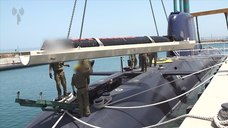
The almost fully operational ‘heavy torpedo’ is more accurate, has a longer range, operates deep under water and avoids being tricked by enemy's systems; test was labeled as a seminal event occuring 'once a decade'.
The Israel Navy successfully concluded on Tuesday a series of tests conducted over the course of the year and declared the new digital, long-range missile dubbed as “heavy torpedo” of the submarine fleet as almost fully operational.
Another series of tests on a smaller scale will be conducted in the future in order to officially declare the torpedo as fully operational.
The torpedo is significantly more accurate than its predecessors and can reach greater distances not only on land but also near vessels in enemy ports and under the sea. The new missile system will soon be integrated into five existing submarines and into a sixth one at a later date once its construction is completed in Germany.
As part of the series of tests, which the IDF decided to disclose to the general public and to its enemies, vessles simulating enemy ships were attacked in Israel’s sovereign waters, as well as targets on land.
According to a senior IDF Navy official, one of the main advantages of the torpedo is the fact that it is digital, unlike the older models, which enhances its accuracy. It also improves control over the missile and allows for the future integration of improvements as software develops.
“We’re talking about the primary underwater missile of our submarine fleet. This is a capability that emulates what we are doing in the world of submarines. That is to say, a capability to damage a target from a range that exceeds the distance of detection of submarines to underwater submarine targets,” said the senior official.
“It has the capability to strike targets at various speeds—either static or those travelling at full speed, also in shallow waters. This gives us an immediate response and significantly improves the capabilities of the current torpedo,” said the Navy officer.
“The upgrade is about sophistication and range," he explained. "The missile would be considered a long-range torpedo by international standards ... The missile's sonar systems are digital unlike the previous model which gives us a lot of flexibility. This is a seminal event which occurs in the IDF Navy once a decade.”
The torpedo can remain operational hundreds of meters under water and one of the most most important parts of the latest test included combining the it with the missile systems of the submarines, which did not limit any of its advantages, the official stated.
“The torpedo also has the capability to deal with deception mechanisms, since the underwater world is becoming very similar to the one above it,” the official claims.
The submarine fleet has recently been largely involved in “interwar” missions which are intended to deter the Iran, Hezbollah and Hamas. Lately, over 60 percent of the submarines’ time in the sea has been allocated for missions, which include intelligence gathering and training.
“The submarines will always be an irreplaceable strategic tool for Israel’s security. They represent our main underwater attacking force," the senior officer said.
"Once the torpedo is equipped with an air-independent propulsion capability in our submarines, we would be able to remain underwater for days. Then its added value will be even greater,” he boasted.
The submarines are also expected to be upgraded in the future in order to minimize the possibility of being located and identified by enemies.
“In the past only the acoustic signature played a part when it came to secrecy, meaning the noise created by the submarine could be caught by the enemy’s sonar. Today, however, more and more sonar systems recognize other active sonars from a distance. Therefore, we’ll change the way the submarines are built in the first place,” concluded the Navy official.
The Israel Navy successfully concluded on Tuesday a series of tests conducted over the course of the year and declared the new digital, long-range missile dubbed as “heavy torpedo” of the submarine fleet as almost fully operational.
Another series of tests on a smaller scale will be conducted in the future in order to officially declare the torpedo as fully operational.
The torpedo is significantly more accurate than its predecessors and can reach greater distances not only on land but also near vessels in enemy ports and under the sea. The new missile system will soon be integrated into five existing submarines and into a sixth one at a later date once its construction is completed in Germany.
As part of the series of tests, which the IDF decided to disclose to the general public and to its enemies, vessles simulating enemy ships were attacked in Israel’s sovereign waters, as well as targets on land.
According to a senior IDF Navy official, one of the main advantages of the torpedo is the fact that it is digital, unlike the older models, which enhances its accuracy. It also improves control over the missile and allows for the future integration of improvements as software develops.
“We’re talking about the primary underwater missile of our submarine fleet. This is a capability that emulates what we are doing in the world of submarines. That is to say, a capability to damage a target from a range that exceeds the distance of detection of submarines to underwater submarine targets,” said the senior official.
“It has the capability to strike targets at various speeds—either static or those travelling at full speed, also in shallow waters. This gives us an immediate response and significantly improves the capabilities of the current torpedo,” said the Navy officer.
“The upgrade is about sophistication and range," he explained. "The missile would be considered a long-range torpedo by international standards ... The missile's sonar systems are digital unlike the previous model which gives us a lot of flexibility. This is a seminal event which occurs in the IDF Navy once a decade.”
The torpedo can remain operational hundreds of meters under water and one of the most most important parts of the latest test included combining the it with the missile systems of the submarines, which did not limit any of its advantages, the official stated.
“The torpedo also has the capability to deal with deception mechanisms, since the underwater world is becoming very similar to the one above it,” the official claims.
The submarine fleet has recently been largely involved in “interwar” missions which are intended to deter the Iran, Hezbollah and Hamas. Lately, over 60 percent of the submarines’ time in the sea has been allocated for missions, which include intelligence gathering and training.
“The submarines will always be an irreplaceable strategic tool for Israel’s security. They represent our main underwater attacking force," the senior officer said.
"Once the torpedo is equipped with an air-independent propulsion capability in our submarines, we would be able to remain underwater for days. Then its added value will be even greater,” he boasted.
The submarines are also expected to be upgraded in the future in order to minimize the possibility of being located and identified by enemies.
“In the past only the acoustic signature played a part when it came to secrecy, meaning the noise created by the submarine could be caught by the enemy’s sonar. Today, however, more and more sonar systems recognize other active sonars from a distance. Therefore, we’ll change the way the submarines are built in the first place,” concluded the Navy official.
3 june 2018
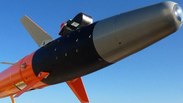
Rafael develops mini-kit, borrowed from fighter jets, to upgrade unguided rockets such as Grads, using Image Adjustment technology as an alternative to GPS, that is prone to enemy jamming.
Rafael Systems recently completed the development a kit that can be integrated into any missile or rocket warhead to improve the accuracy with a three-meter margin of error from the target at a range of 100km.
The Hebrew name for the new system—Electro-optical Precision Integration Kit (EPIK)—translates to “Sharp Flame.” The IDF has not yet decided whether to purchase the system which is based on electro-optics as a more secure and precise alternative to GPS, which can be fooled by an array of jamming systems that are capable of diverting a missile from its target.
In developing the new system, Rafael intergated existing technology used by fighter aircraft which allowed for homing in on the target using photo identification.
A photo of a specific element of the target is pre-uploaded to the warhead’s hard drive. When the rocket or missile approaches the target, it takes a photograph and visually scans the area for positive identification of the target before homing in on it.
The system is appropriate for rockets used by eastern European armies like the 122mm. BM-21 Grad rocket, as it can lower costs. Precision guided rockets can cost hundreds of thousands of dollars while a simple rocket outfitted with Rafael’s kit only costs about $2,000.
“It is clear that there will be a decreasing use of GPS guided munitions in future wars as they can be jammed with equipment purchased on eBay,” a senior Rafael employee involved in the system told Ynet.
“This technology identifies the target by matching high quality photographs, using them to strike the exact pre-determined pixel,” he continued. “Considering a large barrage of rockets launched simultaneously from the same launcher the takedown effect is quite substantial.”
While anti-tank missiles using electro-optics travel at a speed of 180 meters per second, the rockets outfitted with the EPIK kit travel at speeds approaching mach 2, so that targets can be destroyed within less than two minutes from launch.
EPIK was developed as part of a series of tests carried out by Rafael in southern Israel. Currently, the system is “fire and forget,” but the company plans to upgrading it to include remote control capabilities.
“Using this method, each rocket within a barrage will have a different address. If the target is an airport, one rocket will strike the control tower, another the command center, while another strikes the runway or a weapons storage site,” the official told Ynet.
An EPIK kit can be outfitted on a rocket using GPS, like those the IDF currently uses, thereby dramatically increasing its accuracy as a decision can be made regarding which system to utilize based on real time intelligence and weather considerations.
"The system can also receive a picture of the target from a nearby ground force that photographs the target structure and immediately relays the picture back," the official explained.
Rafael Systems recently completed the development a kit that can be integrated into any missile or rocket warhead to improve the accuracy with a three-meter margin of error from the target at a range of 100km.
The Hebrew name for the new system—Electro-optical Precision Integration Kit (EPIK)—translates to “Sharp Flame.” The IDF has not yet decided whether to purchase the system which is based on electro-optics as a more secure and precise alternative to GPS, which can be fooled by an array of jamming systems that are capable of diverting a missile from its target.
In developing the new system, Rafael intergated existing technology used by fighter aircraft which allowed for homing in on the target using photo identification.
A photo of a specific element of the target is pre-uploaded to the warhead’s hard drive. When the rocket or missile approaches the target, it takes a photograph and visually scans the area for positive identification of the target before homing in on it.
The system is appropriate for rockets used by eastern European armies like the 122mm. BM-21 Grad rocket, as it can lower costs. Precision guided rockets can cost hundreds of thousands of dollars while a simple rocket outfitted with Rafael’s kit only costs about $2,000.
“It is clear that there will be a decreasing use of GPS guided munitions in future wars as they can be jammed with equipment purchased on eBay,” a senior Rafael employee involved in the system told Ynet.
“This technology identifies the target by matching high quality photographs, using them to strike the exact pre-determined pixel,” he continued. “Considering a large barrage of rockets launched simultaneously from the same launcher the takedown effect is quite substantial.”
While anti-tank missiles using electro-optics travel at a speed of 180 meters per second, the rockets outfitted with the EPIK kit travel at speeds approaching mach 2, so that targets can be destroyed within less than two minutes from launch.
EPIK was developed as part of a series of tests carried out by Rafael in southern Israel. Currently, the system is “fire and forget,” but the company plans to upgrading it to include remote control capabilities.
“Using this method, each rocket within a barrage will have a different address. If the target is an airport, one rocket will strike the control tower, another the command center, while another strikes the runway or a weapons storage site,” the official told Ynet.
An EPIK kit can be outfitted on a rocket using GPS, like those the IDF currently uses, thereby dramatically increasing its accuracy as a decision can be made regarding which system to utilize based on real time intelligence and weather considerations.
"The system can also receive a picture of the target from a nearby ground force that photographs the target structure and immediately relays the picture back," the official explained.
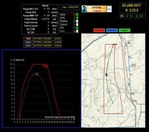
"Within a year we can already have a shelf product and adapt the kit to other size rockets," the source continued. "In the system we also combined target detection using laser detectors to expand operational flexibility and allow a force to hit a target in motion."
The product will be offered initially to eastern European countries using unguided rocket systems. Later, Rafael will develop a relatively small and complete Grad rocket array, which will include the precise warheads for sale to western armies.
In the video footage of the EPIK test, two rockets were fired at a small structure measuring two square meters, which was 25 kilometers from the launcher. The GPS on the rocket's head was deliberately neutralized, and the rocket identified the structure using a pre-loaded image in its software and hit the target. In the second experiment, the system's laser detector was given priority, and it also ended with a precise impact on the target.
The product will be offered initially to eastern European countries using unguided rocket systems. Later, Rafael will develop a relatively small and complete Grad rocket array, which will include the precise warheads for sale to western armies.
In the video footage of the EPIK test, two rockets were fired at a small structure measuring two square meters, which was 25 kilometers from the launcher. The GPS on the rocket's head was deliberately neutralized, and the rocket identified the structure using a pre-loaded image in its software and hit the target. In the second experiment, the system's laser detector was given priority, and it also ended with a precise impact on the target.
